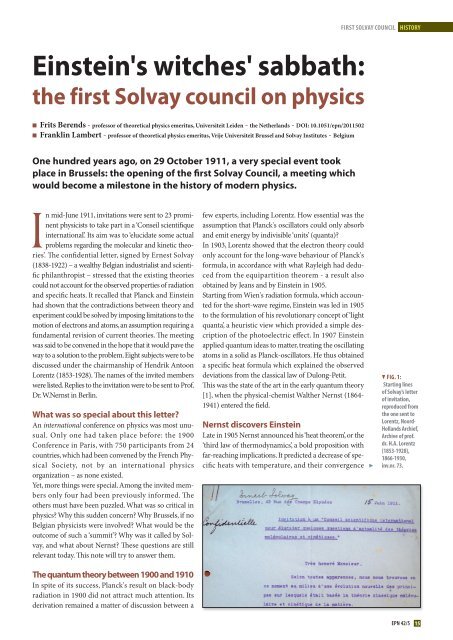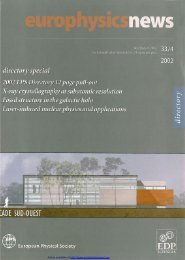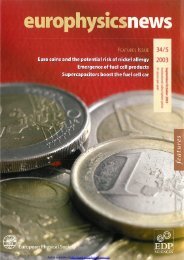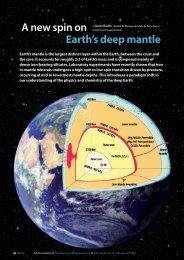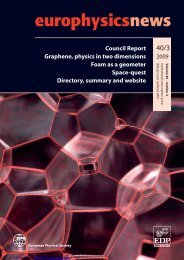PDF (11.37 MB) - Europhysics News
PDF (11.37 MB) - Europhysics News
PDF (11.37 MB) - Europhysics News
Create successful ePaper yourself
Turn your PDF publications into a flip-book with our unique Google optimized e-Paper software.
Einstein's witches' sabbath:<br />
the first Solvay council on physics<br />
■ Frits Berends - professor of theoretical physics emeritus, Universiteit Leiden - the Netherlands - DOI: 10.1051/epn/2011502<br />
■ Franklin Lambert - professor of theoretical physics emeritus, Vrije Universiteit Brussel and Solvay Institutes - Belgium<br />
One hundred years ago, on 29 October 1911, a very special event took<br />
place in Brussels: the opening of the first Solvay Council, a meeting which<br />
would become a milestone in the history of modern physics.<br />
In mid-June 1911, invitations were sent to 23 prominent<br />
physicists to take part in a ‘Conseil scientifique<br />
international’. Its aim was to ‘elucidate some actual<br />
problems regarding the molecular and kinetic theories’.<br />
�e confidential letter, signed by Ernest Solvay<br />
(1838-1922) – a wealthy Belgian industrialist and scientific<br />
philanthropist – stressed that the existing theories<br />
could not account for the observed properties of radiation<br />
and specific heats. It recalled that Planck and Einstein<br />
had shown that the contradictions between theory and<br />
experiment could be solved by imposing limitations to the<br />
motion of electrons and atoms,an assumption requiring a<br />
fundamental revision of current theories. �e meeting<br />
was said to be convened in the hope that it would pave the<br />
way to a solution to the problem.Eight subjects were to be<br />
discussed under the chairmanship of Hendrik Antoon<br />
Lorentz (1853-1928). �e names of the invited members<br />
were listed.Replies to the invitation were to be sent to Prof.<br />
Dr.W.Nernst in Berlin.<br />
What was so special about this letter?<br />
An international conference on physics was most unusual.<br />
Only one had taken place before: the 1900<br />
Conference in Paris, with 750 participants from 24<br />
countries, which had been convened by the French Physical<br />
Society, not by an international physics<br />
organization – as none existed.<br />
Yet, more things were special.Among the invited members<br />
only four had been previously informed. �e<br />
others must have been puzzled. What was so critical in<br />
physics? Why this sudden concern? Why Brussels, if no<br />
Belgian physicists were involved? What would be the<br />
outcome of such a ‘summit’? Why was it called by Solvay,<br />
and what about Nernst? �ese questions are still<br />
relevant today. �is note will try to answer them.<br />
Thequantumtheorybetween1900and1910<br />
In spite of its success, Planck's result on black-body<br />
radiation in 1900 did not attract much attention. Its<br />
derivation remained a matter of discussion between a<br />
few experts, including Lorentz. How essential was the<br />
assumption that Planck's oscillators could only absorb<br />
and emit energy by indivisible ‘units’ (quanta)?<br />
In 1903, Lorentz showed that the electron theory could<br />
only account for the long-wave behaviour of Planck's<br />
formula, in accordance with what Rayleigh had deduced<br />
from the equipartition theorem - a result also<br />
obtained by Jeans and by Einstein in 1905.<br />
Starting from Wien's radiation formula, which accounted<br />
for the short-wave regime, Einstein was led in 1905<br />
to the formulation of his revolutionary concept of ‘light<br />
quanta’, a heuristic view which provided a simple description<br />
of the photoelectric effect. In 1907 Einstein<br />
applied quantum ideas to matter, treating the oscillating<br />
atoms in a solid as Planck-oscillators. He thus obtained<br />
a specific heat formula which explained the observed<br />
deviations from the classical law of Dulong-Petit.<br />
�is was the state of the art in the early quantum theory<br />
[1], when the physical-chemist Walther Nernst (1864-<br />
1941) entered the field.<br />
Nernst discovers Einstein<br />
Late in 1905 Nernst announced his‘heat theorem’, or the<br />
‘third law of thermodynamics’, a bold proposition with<br />
far-reaching implications. It predicted a decrease of specific<br />
heats with temperature, and their convergence<br />
firST Solvay CounCil HiSTory<br />
�<br />
� fig. 1:<br />
Starting lines<br />
of Solvay’s letter<br />
of invitation,<br />
reproduced from<br />
the one sent to<br />
lorentz, noord-<br />
Hollands archief,<br />
archive of prof.<br />
dr. H.a. lorentz<br />
(1853-1928),<br />
1866-1930,<br />
inv.nr. 73.<br />
EPN 42/5 15


